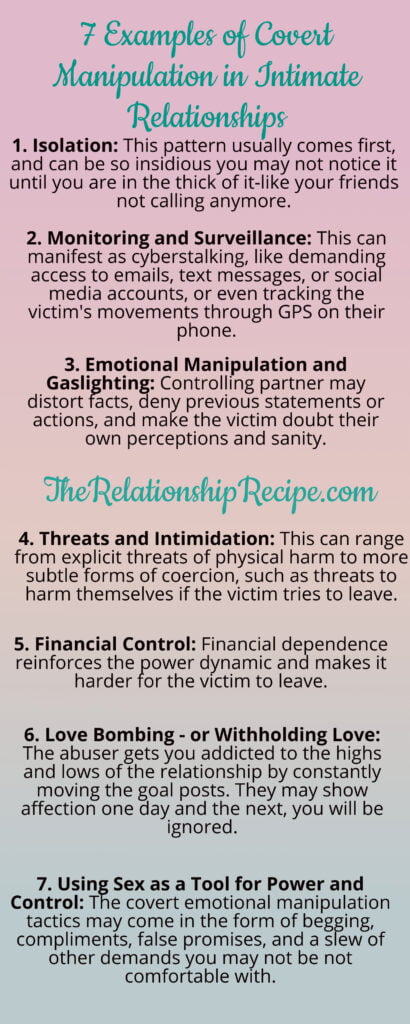The 7 Most Common Covert Emotional Manipulation Tactics in Relationships
Relationships are meant to be spaces of love, respect, and mutual support. However, there are instances where control dynamics creep in, turning what should be a partnership, into a source of manipulation and coercion.
Covert manipulation serves as the basis for various types of domestic abuse. It revolves around power dynamics within relationships. Physical, financial, and manipulative abuse all stem from covert emotional manipulation tactics.
What are the Main Phases of Covert Manipulation?
Coercive control, also known as covert manipulation, is a term gaining recognition in recent years, refers to a pattern of behavior that seeks to dominate, intimidate, and manipulate a partner.

Covert manipulation unfolds gradually, typically progressing through eight distinct base-line phases, and I would be remiss not discussing them first:
- Idealization: The perpetrator lavishes the victim with affection, creating deep intimacy and dependence.
- Devaluation: Criticism from the perpetrator chips away at the victim’s self-esteem and confidence.
- Isolation: The perpetrator controls the victim’s social interactions, severing ties with their support system.
- Demands and Threats: Through intimidation, the perpetrator exerts control over the victim’s actions with demands and threats.
- Denials and Minimization: The perpetrator gaslights the victim, denying their abusive conduct and distorting reality.
- Guilt and Shame: Manipulation ensues as the perpetrator induces feelings of guilt and shame in the victim.
- Humiliation and Degradation: Deliberate humiliation and degradation by the perpetrator further diminish the victim’s self-worth.
- Scaring and Terrorization: Creating an atmosphere of fear and perpetual unease, the perpetrator makes the victim feel constantly unsafe.
Now, to break it down a bit further — within these 8 phases, there are noticeable patterns of covert manipulation. Understanding these patterns is important for identifying and addressing them effectively.

Recognizing Patterns of Covert Emotional Manipulation Tactics
- Isolation:
One of the major hallmarks of covert manipulation is isolation, and it deserves repeating. This pattern usually comes first, and can be so insidious you may not notice it until you are in the thick of it-like your friends not calling anymore. The controlling partner may gradually cut off the other person from their support networks, including friends, family, and even work colleagues. This isolation can make the victim feel entirely dependent on their partner, heightening the control exerted over them.
2. Monitoring and Surveillance:
Constant monitoring and surveillance are another common feature. This can manifest as cyberstalking, like demanding access to emails, text messages, or social media accounts, or even tracking the victim’s movements through GPS on their phone. The controlled individual often feels as if they have no privacy or autonomy.

3. Emotional Manipulation and Gaslighting:
Use of covert emotional manipulation tactics typically involves subtle distortion and gaslighting. The controlling partner may distort facts, deny previous statements or actions, and make the victim doubt their own perceptions and sanity. Over time, this erodes the victim’s self-esteem and confidence.
4. Threats and Intimidation:
Threats and intimidation tactics are frequently used to maintain control. This can range from explicit threats of physical harm to more subtle forms of coercion, such as threats to harm themselves if the victim tries to leave. Fear becomes a tool for the controlling partner to maintain dominance.
5. Financial Control:
Controlling access to finances is another common pattern. This could involve giving the victim an allowance, controlling their spending, or even preventing them from working outside the home. Financial dependence reinforces the power dynamic and makes it harder for the victim to leave.

6. Love Bombing – or Withholding Love:
The abuser gets you addicted to the highs and lows of the relationship by constantly moving the goal posts. They may show affection one day, and the next, you will be ignored. Mean, then nice. Mean, then nice….and on and on. This constant “Jekyll and Hyde” action keeps you on 24-7 hyper-alert so as not to upset them. You may start to crave the love bombing and affection. This incessant “pulling the rug out from under you” creates a trauma bond that is difficult to shake.
7. Using Sex as a Tool for Power and Control:
With covert emotional manipulation, intimacy and sexual boundaries will be violated under the guise of wanting to “try something new.” The covert emotional manipulation tactics may come in the form of begging, compliments, false promises, and a slew of other demands you may not be comfortable with. If it happens once, it will likely escalate, and continue.

Some Relatable Real Life Examples of Covert Emotional Manipulation Tactics
“My partner always insisted on knowing my whereabouts at all times, demanding constant updates on my location. If I didn’t comply, they would accuse me of hiding something or being untrustworthy, creating a sense of fear and guilt whenever I wanted to spend time apart.”
…..
“Whenever I expressed a different opinion or disagreed with my partner, they would belittle me, dismissing my thoughts as irrelevant or stupid. Over time, I started questioning my own judgment, feeling like I couldn’t trust my own perceptions.”
…..
“My partner controlled all our finances, giving me a strict allowance and scrutinizing every purchase I made. Anytime I wanted to buy something for myself, they would criticize me for being wasteful or irresponsible, making me feel guilty for wanting basic necessities.”
…..

How to Identify Covert Manipulation:
Trust Your Instincts: If something feels off in your relationship, trust your instincts. Pay attention to how you feel when interacting with your partner, and reflect on any patterns of behavior that cause discomfort or unease.
Observe Behavioral Changes: Look out for significant changes in your behavior or your partner’s behavior. This could include becoming more withdrawn, anxious, or fearful around your partner, or noticing increasingly controlling behaviors from them.
Seek Outside Perspective: Talk to trusted friends or family members about your concerns. Sometimes, an outside perspective can help you see patterns that you might not have noticed before, especially if you’ve been isolated from your support network.
Educate Yourself: Learn about the signs of covert manipulation and familiarize yourself with resources available for support. Knowledge is empowering and can help you make informed decisions about your relationship.

What to Do After Identifying Covert Manipulation
Reach Out for Support: You are not alone. Reach out to friends, family, or organizations specializing in domestic abuse for support and guidance. They can offer resources, advice, and a safe space to discuss your situation.
Safety Planning: Develop a safety plan for yourself, which may include finding a safe place to stay if you decide to leave the relationship. Secure important documents, and establish a code word or signal with trusted individuals to indicate when you’re in danger.

Consider Professional Help: Seeking therapy or counseling can be incredibly beneficial in navigating the complexities of covert manipulation and rebuilding your sense of self-worth and independence.
Know Your Rights: Educate yourself about your legal rights and options. In many jurisdictions, there are laws and resources available to protect you from covert emotional manipulation tactics and domestic abuse. Many divorce lawyers offer a free consultation if leaving the relationship is the path you want to take.
Take Steps Toward Independence: If you feel safe to do so, take steps toward reclaiming your independence. This may involve seeking employment, establishing a more independent mindset, reconnecting with friends and family, and establishing a support network outside the relationship.

Conclusion:
When one partner is using covert emotional manipulation tactics, it is a destructive pattern of behavior that can have profound and lasting effects on its victims. By recognizing the common patterns and tactics used in covert manipulation relationships, you can take steps to identify and address these dynamics.
Remember, you deserve to be in a relationship characterized by respect, equality, and mutual support. If you find yourself in a relationship of covert manipulation, know that there is help available, and you have the strength to reclaim your autonomy and rebuild your life.
Before You Go:
This is one of my favorite books on emotional manipulation through coercive control. I have read it myself and recommended it to several friends who benefitted from it.
Coercive Control: How Men Entrap Women in Personal Life
Evan Stark, renowned for founding one of the earliest shelters for abused women in the US, offers a groundbreaking perspective on domestic violence. He argues that it extends beyond physical harm, encompassing controlling behaviors akin to tactics seen in terrorism and hostage situations.
Stark’s research, drawing from legal records, interviews, and FBI data, exposes the various ways men assert dominance over women, from monitoring communication to dictating daily activities.
He challenges the narrow view of domestic abuse as solely physical, advocating for a broader understanding that encompasses violations of women’s autonomy and human rights. Stark’s call to reframe abuse as a crime against liberty highlights the urgency of addressing systemic inequality and ensuring women’s rights to freedom and safety.
This post may contain affiliate links. I earn from qualifying Amazon purchases at no extra cost to you.





